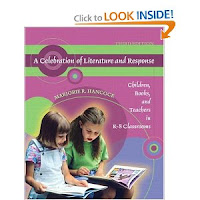When I consult in school districts, I often have to first sort through what they say they want me do to get to what they really want me to do. For example, schools often insist that their students need more work with reader response when what they actually mean is that they need help getting kids to effectively respond to test prompts. Here we have an apples and oranges situation. No matter how hard we try, we can’t turn a crunchy red apple into a juicy sectioned orange, or vice versa. They’re just different.
While prepping for tests is important, this can be successfully done several weeks before the test without taking precious time away from literacy experiences that really matter. Children need opportunities to interact with texts in a way that it brings them to life—in the sense that Louise Rosenblatt suggested decades ago in her transactional theory of reader response. Rosenblatt’s theory encourages the interaction of the reader and the text in a literary event. And, for me, “interaction,” more than any other word best describes what must occur if children are to genuinely and deeply understand what they read.
In support, I offer a mentor quote from P. David Pearson et al highlighting the importance of interaction:

"We can no longer think of reading comprehension as a series of discrete skills that can be summed to achieve comprehension ability. Instead, we see comprehension as a complex process involving interactions between readers and texts in various contexts for various purposes." (“Developing Expertise in Reading Comprehension,” Technical Report #512, 1990, p. 6)
And now let me recommend a book that describes a wide range of practices to engage children in authentic interactions with and responses to text. It’s Marjorie R. Hancock’s
A Celebration of Literature and Response: Children, Books, and Teachers in K-8 Classrooms. In addition, it provides up-to-date lists of children’s literature to use in guiding children through responding to traditional tales and modern fantasy, poetry, realistic and historical fiction, and informational texts. Since the price of the book is steep (around $70.00), I recommend encouraging your principal to order one or two for your professional reference library. (And, if I might add, ignore the all-over-the-place ratings on Amazon. For the life of me, I can’t figure them out. This is a stellar resource.)
 One surefire way to help build background knowledge is to read more informational texts aloud to students. Make a commitment to alternate between fiction and nonfiction. Or follow the rule of thumb I give to students who resist either one genre or the other—for every two fiction (or nonfiction) books you read, you have to read a nonfiction (or fiction) title. Once you wet your appetite for nonfiction, they’ll be no turning back.
One surefire way to help build background knowledge is to read more informational texts aloud to students. Make a commitment to alternate between fiction and nonfiction. Or follow the rule of thumb I give to students who resist either one genre or the other—for every two fiction (or nonfiction) books you read, you have to read a nonfiction (or fiction) title. Once you wet your appetite for nonfiction, they’ll be no turning back.  Then there’s the matter of what books to read. I like to select read aloud titles based on topics that excite students or those that relate to content-area topics they'll be studying. You might also decide to pair two books on the same topic. That way you can compare the information presented in each and the text features and access features used, and you’ll be sure to give kids the opportunity to hear the same content-area vocabulary repeated throughout out both readings. Frogs! from Time for Kid’s and Frogs! from National Geographic are excellent titles to read and compare if your kids are studying life-cycles. What are some of your favorite nonfiction titles?
Then there’s the matter of what books to read. I like to select read aloud titles based on topics that excite students or those that relate to content-area topics they'll be studying. You might also decide to pair two books on the same topic. That way you can compare the information presented in each and the text features and access features used, and you’ll be sure to give kids the opportunity to hear the same content-area vocabulary repeated throughout out both readings. Frogs! from Time for Kid’s and Frogs! from National Geographic are excellent titles to read and compare if your kids are studying life-cycles. What are some of your favorite nonfiction titles?











Comments